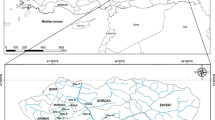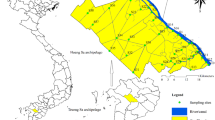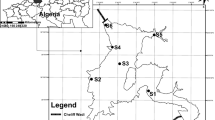Abstract
This study presents an assessment of surface water quality using multivariate statistical techniques for the Ahlat Marshes in Turkey. In total, 23 physicochemical parameters were analyzed by taking seven different sample sites seasonally between November 2015 and August 2016 for a period of 1 year. The values obtained were compared with the guidelines for inland water resources as suggested by the national standards. At the same time, a pressure-impact analysis was performed by using water quality data obtained for the Ahlat Marshes. As a result, the Ahlat Marshes showed Class IV water quality feature for TOC and Class III for temp, pH and NO2−, according to the national regulations. In an impact analysis, the same four parameters had a “high impact.” It was determined through factor analysis that seven factors explained 80.78% of the total variation in the data. Cluster analysis yielded good results with four different similarity groups, among the seven sampling sites reflecting the water quality characteristics of the wetland systems. It was concluded that fish farms, mining sites, septic tanks, an agricultural area near to the marshes and geogenic origin were all factors affecting the water quality of the Ahlat Marshes. This study was performed the first time; the result shows that there is a no serious risk situation. However, this does not mean that the marshes are clean. It is of vital importance not to act too late in taking the necessary precautions and is monitored at regular intervals for the effective management and sustainability of these wetlands.




Similar content being viewed by others
References
APHA. (1998). Standard methods for the examination of water and wastewater. American Public Health Association Washington.
Arınç, K. (1997). Ahlat İlçesinde Doğal Barınaklar (Mağara Konutlar) ve Bazı Prehistorik Yerleşme İzleri. Atatürk Üniversitesi Sosyal Bilimler Dergisi, 0(24): 105-139 (in Turkish).
Arslan, H., & Yildirim, D. (2011). Water quality assessment of the drainage canals in Bafra Plain using multivariate statistical analysis. Journal of Agricultural Faculty of Gaziosmanpaşa University, 28(2), 61–71.
Avramidis, P., Geraga, M., Lazarova, M., & Kontopoulos, N. (2013). Holocene record of environmental changes and palaeoclimatic implications in Alykes Lagoon, Zakynthos Island, western Greece, Mediterranean Sea. Quaternary International, 293, 184–195.
Barakat, A., El Baghdadi, M., Rais, J., Aghezzaf, B., & Slassi, M. (2016). Assessment of spatial and seasonal water quality variation of Oum Er Rbia River (Morocco) using multivariate statistical techniques. International Soil and Water Conservation Research, 4(4), 284–292.
Bilgin, A. (2015). An assessment of water quality in the Coruh Basin (Turkey) using multivariate statistical techniques. Environmental Monitoring and Assessment, 187(11), 721.
Chandra, R., Nishadh, K. A., & Azeez, P. A. (2010). Monitoring water quality of Coimbatore wetlands, Tamil Nadu, India. Environmental Monitoring and Assessment, 169(1–4), 671–676.
Demir, A., & Selek, Z. (2009). Akyatan lagününde tuzluluk ve bazı kirlilik düzeylerinin saptanarak coğrafi bilgi sistemi destekli dağılımlarının belirlenmesi. Çukurova Üniversitesi Fen Bilimleri Enstitüsü Dergisi, 20(1), 187–199 (in Turkish).
Demir Yetis, A. (2019). Bitlis Ahlat Sazlıkları Yüzey Sularında Bazı Ağır Metal Düzeylerinin Araştırılması. Çukurova Üniversitesi Mühendislik-Mimarlık Fakültesi Dergisi, 34(1):1–12 (in Turkish).
Demir Yetis, A., & Selek, Z. (2015). Determination of total and fecal coliforms of Akyatan Lagoon in terms of microbiological pollution. Arabian Journal of Geosciences, 8, 1125–1132. https://doi.org/10.1007/s12517-014-1268-3.
Demir Yetis, A., Selek, Z., Seckin, G., & Davutluoglu, O. I. (2014). Water quality of Mediterranean coastal plains: conservation implications from the Akyatan Lagoon, Turkey. Environmental Monitoring and Assessment, 186, 7631–7642.
Elmataş, N. (2009). Agricultural Land Use in Ahlat District. Gaziantep University Journal of Social Sciences, 7(2), 479–501 (in Turkish).
Filik Iscen, C., Emiroglu, Ö., Ilhan, S., Arslan, N., Yilmaz, V., & Ahiska, S. (2008). Application of multivariate statistical techniques in the assessment of surface water quality in Uluabat Lake, Turkey. Environmental Monitoring and Assessment, 144, 269–276.
GDWM (Republic of Turkey Ministry of Agriculture and Forestry, General Directorate of Water Management). (2017). Gediz Basin River Basin Management Plan Preparation Project Report, Ankara (in Turkish).
GDWM (Republic of Turkey Ministry of Agriculture and Forestry, General Directorate of Water Management). (2018). Kucuk Menderes Basin River Basin Management Plan Preparation Project Report, Ankara (in Turkish).
Helena, B., Pardo, R., Vega, M., Barrado, E., Fernández, J. M., & Fernández, L. (2000). Temporal evolution of groundwater composition in an alluvial aquifer (Pisuerga River, Spain) by principal component analysis. Water Research, 34(3), 807–816.
Isunju, J. B., & Kemp, J. (2016). Spatiotemporal analysis of encroachment on wetlands: A case of Nakivubo wetland in Kampala, Uganda. Environmental Monitoring and Assessment, 188(4), 203. https://doi.org/10.1007/s10661-016-5207-5.
Karakus, C. B. (2019). Evaluation of water quality of Kızılırmak River (Sivas/Turkey) using geo-statistical and multivariable statistical approaches. Environment, Development and Sustainability. https://doi.org/10.1007/s10668-019-00472-8.
Khuhawar, M. Y., Zaman Brohi, R. O., Jahangir, T. M., & Lanjwani, M. F. (2018). Water quality assessment of Ramser site, Indus Delta, Sindh, Pakistan. Environmental Monitoring and Assessment, 190(8), 492.
Kim, J. Y., Bhatta, K., Rastogi, G., Muduli, P. R., Do, Y., Kim, D. K., et al. (2016). Application of multivariate analysis to determine spatial and temporal changes in water quality after new channel construction in the Chilika Lagoon. Ecological Engineering, 90, 314–319.
Liu, C. W., Lin, K. H., & Kuo, Y. M. (2003). Application of factor analysis in the assessment of groundwater quality in a Blackfoot disease area in Taiwan. Science in the Total Environment, 313(1–3), 77–89.
Mackay, A., Davidson, T., Wolski, P., Mazebedi, R., Masamba, W., Huntsman-Mapila, P., et al. (2011). Spatial and seasonal variability in surface water chemistry in the Okavango Delta, Botswana: A multivariate approach. Wetlands, 31, 815–829.
MAF (Ministry of Agriculture and Forestry). (2016). Action Plan for Lakes and Wetlands, Republic of Turkey Ministry of Agriculture and Forestry, General Directorate of Water Management, Ankara, Turkey (in Turkish).
Marinovic, A., & Ruzdjak, D. (2015). Evaluation of river water quality variations using multivariate statistical techniques: Sava River (Croatia): A case study. Environmental Monitoring and Assessment, 187(4), 1–14.
Mostafaei, A. (2014). Application of multivariate statistical methods and water-quality index to evaluation of water quality in the Kashkan River. Environmental Management, 53, 865–881.
Nasirian, H., Irvine, K. N., Sadeghi, S. M. T., Mahvi, A. H., & Nazmara, S. (2016). Assessment of bed sediment metal contamination in the Shadegan and Hawr Al Azim wetlands, Iran. Environmental Monitoring and Assessment, 188, 107.
Naz, M., Uyanik, S., Yesilnacar, M. I., & Sahinkaya, E. (2009). Side-by-side comparison of horizontal subsurface flow and free water surface flow constructed wetlands and artificial neural network (ANN) modeling approach. Ecological Engineering, 35, 1255–1263.
Nergiz, H., Demir Yetis, A., Yetis, R. (2018). The effect of water quality on water birds: The case of Ahlat Marshes. In International conference on stem and educational sciences (pp. 3–5) (in Turkish).
Nyairo, W. N., Owuor, P. O., & Kengara, F. O. (2015). Effect of anthropogenic activities on the water quality of Amala and Nyangores tributaries of River Mara in Kenya. Environmental Monitoring and Assessment, 187, 691.
Ozler, M. H. (2003). Hydrochemistry and salt-water intrusion in the Van aquifer, East Turkey. Environmental Geology, 43(7), 759–775.
Simeonov, V., Stratis, J. A., Samara, C., Zachariadis, G., Voutsa, D., & Anthemidis, A. (2003). Assessment of the surface water quality in Northern Greece. Water Research, 37(17), 4119–4124.
Singh, K. P., Malik, A., Mohan, D., & Sinha, S. (2004). Multivariate statistical techniques for the evaluation of spatial and temporal variations in water quality of Gomti River (India): A case study. Water Research, 38(18), 3980–3992.
Sojka, M., Siepak, M., Ziola, A., Frankowski, M., Murat-Blazejewska, S., & Siepak, J. (2008). Application of multivariate statistical techniques to evaluation of water quality in the Mala Welna River (Western Poland). Environmental Monitoring and Assessment, 147(1–3), 159–170.
Solgi, E., & Galangashi, M. M. (2018). Assessing the health of marine and lacustrine wetland using measurement of heavy metals in fish species: Case study from two Iranian international wetland (Gomishan and Zarivar). Environmental Nanotechnology, Monitoring and Management, 10, 73–78.
TSWQR (Turkish Surface Water Quality Regulation). (2012). Official Gazette dated 30 November 2012 and numbered 28483 (in Turkish).
Tuboi, C., Irengbam, M., & Hussain, S. A. (2018). Seasonal variations in the water quality of a tropical wetland dominated by floating meadows and its implication for the conservation of a wetland of international importance. Physics and Chemistry of the Earth, 103, 107–114.
TW (Turkey Wetlands). (2018). http://www.turkiyesulakalanlari.com/sulak-alanlar. Accessed 09/11/2018 (in Turkish).
TWPCR (Turkish Water Pollution Control Regulation). (2004). Official Gazette dated 31 December 2004 and numbered 25687 (in Turkish).
Varol, M., Gökot, B., Bekleyen, A., & Şen, B. (2012). Spatial and temporal variations in surface water quality of the dam reservoirs in the Tigris River basin, Turkey. CATENA, 92, 11–21.
Vega, M., Pardo, R., Barrado, E., & Deban, L. (1998). Assessment of seasonal and polluting effects on the quality of river water by exploratory data analysis. Water Resource, 32(12), 3581–3592.
WFD. (2000). Water Framework Directive, 2000/60/EC of the European Parliament and of the Council of 23 October 2000.
Yetis, R., Atasoy, A. D., Demir Yetis, A., Yesilnacar, M. I. (2018). Balıklıgöl Havzası Su Kaynaklarının Nitrat ve Nitrit Seviyelerinin Belirlenmesi. Çukurova Üniversitesi Mühendislik-Mimarlık Fakültesi Dergisi, 33(1): 47-54 (in Turkish).
Yetis, R., Demir Yetis, A., Atasoy, A. D., & Yesilnacar, M. I. (2019). Hydrogeochemical characteristics and quality assessment of groundwater in Balikligol Basin, Sanliurfa, Turkey. Environmental Earth Sciences, 78, 331.
Yilmaz, V. (2009). The investigation of water quality parameters of Turkey’s Rivers with multivariate statistical analysis methods. Selcuk University Graduate School of Natural and Applied Sciences, Department of Civil Engineering, Master’s Thesis (in Turkish).
Acknowledgements
The author would like to sincerely thank Lec. Recep YETIŞ, from the Vocational School of Health Services of Bitlis Eren University for his contribution to the field work of this study, and to Cumali TURKOGLU, Branch Manager at the Sanliurfa Water and Sewerage Administration General Directorate Treatment Plant, for his contribution to water quality data.
Author information
Authors and Affiliations
Corresponding author
Additional information
Publisher's Note
Springer Nature remains neutral with regard to jurisdictional claims in published maps and institutional affiliations.
Rights and permissions
About this article
Cite this article
Demir Yetis, A., Akyuz, F. Water quality evaluation by using multivariate statistical techniques and pressure-impact analysis in wetlands: Ahlat Marshes, Turkey. Environ Dev Sustain 23, 969–988 (2021). https://doi.org/10.1007/s10668-020-00690-5
Received:
Accepted:
Published:
Issue Date:
DOI: https://doi.org/10.1007/s10668-020-00690-5




